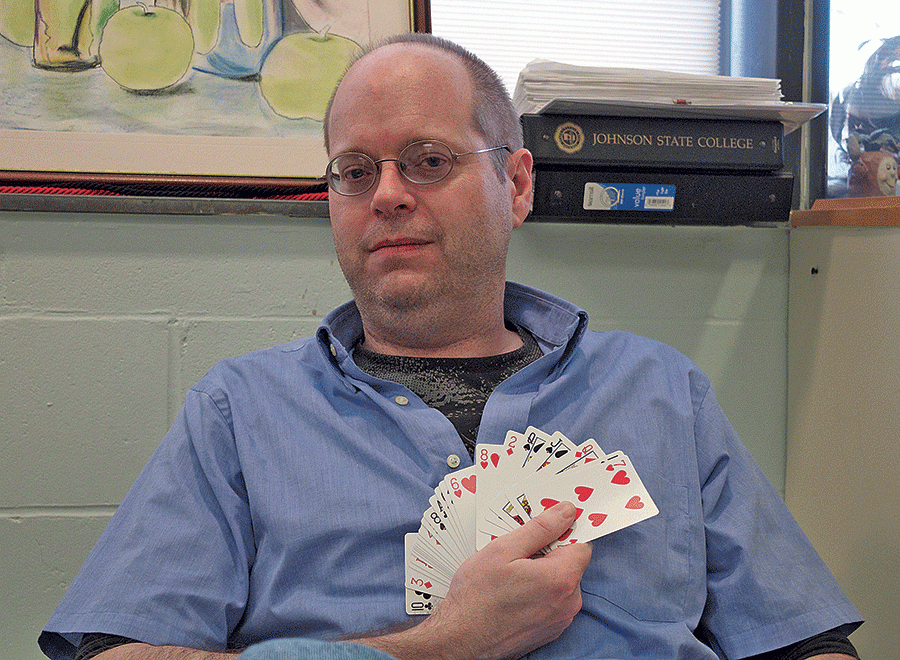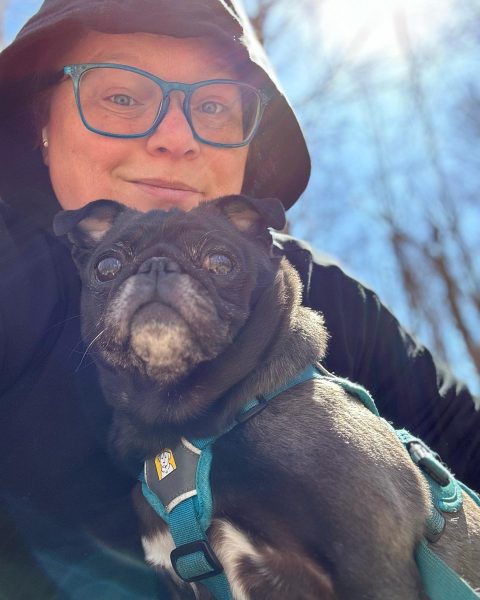Poker Face
Shane Stacey
As he leans against the leather railing, a massive stack of chips by his elbow, Shane Stacey studies his cards with the precision of a jeweler. Beyond the roving gaze of ESPN’s cameras, a silent crowd sunk deep in stadium seating holds a collective breath. The dealer lays a fifth card upon the table and the pot grows with the final round of betting. Stacey lays down his hand and gives his opponent a gracious nod. Every game he has ever played led to this moment.
He reaches forward and rakes in $166,000.
That summer in Las Vegas, the summer of 2008, marked the high point of Stacey’s career as a professional poker player. Two years before, Stacey was just another cog in the wheel of corporate America. He’d been working at a call center in Chicago since 2003, managing the recruitment of patients for pharmaceutical trials. At this point, poker was little more than a somewhat lucrative hobby.
“It was the first thing I would turn to when it came to recreational time,” Stacey said, seated comfortably in his glassed-in office at Johnson State College’s Academic Support Services in Dewey Hall. “Online is so convenient. In a live poker game, you sit at one table and see about 30-40 hands per hour. Online, you can easily sit at a dozen tables at one time with 50-60 hands an hour.”
Stacey thread his fingers as he spoke, moving quickly through his past with the same laser-guided precision he demonstrates with every struggling math student who walks through his door.
Stacey was first introduced to No-Limit Texas Hold’Em in 2002, during a late night channel surfing session that ended with reruns of ESPN. He had never seen anything like it. “The concept of no limit really blew my mind,” he said, his rimless glasses glinting in the afternoon light. “You have the ability to bet anywhere, from nothing to every chip in front of you. I was fascinated watching this footage.”
The next day, he hit a local bookstore and picked up a copy of “No-Limit Hold’Em for Advanced Players.”
As an absolute novice, much of the book went over his head, but with only a 45-minute drive to Chicago’s Riverboat Casinos, he soon started playing regularly.
He discovered internet poker about a year later, taking advantage of the speed and convenience an online table offers. The learning process was not without fits and starts. “Before we were married, my girlfriend and I would log into an account together and we’d play alternating hands in a tournament. That led to war, at times,” Stacey laughs, “but we did well, even with two brains looking at the same thing. Later, I took it a few steps further. I became far better read on the subject, I played more hours, and I dedicated more time to online, though she is still a capable player. ”
The transition from hobbyist to full-time pro came during a freezing Chicago January in 2006. That month, Stacey made $7,000 between his live and online tables. Not only was this enough to live on, earning it was significantly more gratifying than anything in his corporate life. “I was sick of working through this grind,” he said, “and after my good month I decided I was going to bag it. I was going to give poker a go as my primary source of income.”
He was still living in Chicago when he came back to Vermont to visit his family. Thanks to the ease of online poker rooms, Stacey could engage in his new vocation anywhere in the country. As a result, and after a couple of weeks spent camping out in his parent’s living room, he made an additional $3,000.
Poker, it seemed, could prove a legitimate option.
Stacey and his girlfriend left Chicago later that year. Living in Vermont, with only a handful of assets and poker as a primary source of income, Stacey quickly landed in a construction job for a three-month stint. “I wasn’t used to the variants, and they killed me,” Stacey said. “If I had read more, I probably would’ve decided against the path I took. I didn’t have an appropriate poker bank roll to sustain highs and lows. I decided I was just going to put money down and play poker.”
After a holiday winning streak put Stacey back on his feet, he was introduced to his first set of wealthy backers through the web. Backers add a certain kind of meta-game to the world of professional poker. By collecting and funding players who stand to win a decent amount of money, backers are effectively betting on a player’s ability to make, and win, bets. For Stacey, these backers provided some financial relief, as he was no longer risking his own financial resources in his games.
Stacey stresses this point in particular: “I was fortunate enough to get into a financial situation where I had other people covering my costs. They were also taking part of the profits as a result, and once you remove the tax obligation of the top, you often end up with a far more reasonable amount.”
Tournament success with his backers eventually gave Stacey his first taste of the main event. The World Series of Poker, held every summer in Las Vegas, is known for shelling out prizes worth millions of dollars. Separated into as many as 60 separate events, players and backers from across the globe descend on Vegas for upwards of five weeks at a time. Each player competes not only for the money at each table, but for bracelets worth half a million dollars.
At the time, Stacey only competed in two events, each with a $1,500 buy-in. In his second game, he placed 15th out of 2,700 participants and won $30,000. He spent the time in a five bedroom miniature mansion, complete with a hot tub connected to a pool via waterfall, but that was hardly the most memorable display of wealth.
“The owner of our website took us out to dinner,” Stacey remembered, “and we were eating on the 53’rd floor of the Rio. It was an expensive meal, but the owner reaches into his pocket and pulls out this onion of bills with a rubber band around it, all hundreds. He peels off several bills and we walk out. That was the lifestyle. It was what people did.”
In 2008, Stacey hit his all-time high. He saved enough money to stay in Vegas for five weeks, with his backers staking in several of the series’ main events. “I went out there, and had five weeks of absolute nothing. During my second-to-last event, I took $1,500 and found myself at the final table, finishing fifth place out of 2,300 people. I made $166,000 and change.”
The tournament director only had four words for him: “Sick fucking beat, man.”
“It was a mind-altering experience,” Stacey said of his winnings. “I basically learned to completely devalue money. I found out I could fit $7,000 comfortably between my thumb and forefinger, and it’s amazing how easily that fits in your pocket. Not only that, I’ve seen friends flipping coins for $3,000 in the hallway. For them, that was almost as much fun as playing poker. It’s a ridiculous scene. Everyone walks around with hoodies, big-ass watches, and $5,000 to $10,000 in their cargo shorts. We ate in the finest restaurants in Vegas wearing schlub clothes. It was a cash economy; no one cared what you looked like as long as you paid your bill and didn’t cause a disturbance.”
Stacey smiled and shook his head: “Money was just a medium of exchange. It was a way to have fun. If I have a lot of money, I’m going to spend a lot of money. I’ve never been particularly good about keeping my personal control there.”
The summer of 2009 showed a marked downturn in Stacey’s luck at any kind of table. That year in Vegas was a “total train wreck,” with Stacey winning not one of his 20-some odd events. His losses online, however, proved the most worrisome. Over a six-month period, Stacey accumulated a $25,000 loss. He didn’t make a dime.
“That can be really tough,” Stacey said, a slight edge in his normally upbeat tone. “It’s hard on the household, hard on the psyche, and you start to doubt yourself and what you’re able to do. My backers kept behind me and I turned it around, but I thought the black hole was never going to end.”
Unable to provide a steady income for the following year, Stacey took up a part-time job at Academic Support Services. Tutoring had been his primary job as an undergraduate at JSC, and he slipped back into the role easily for 20 hours a week. Poker had far too many holes, though Stacey admits the earning potential exists. When his backers trimmed him and many other players from their website, Stacey came back to JSC in his current full-time position. However, Stacey thinks anybody who sticks to poker for the money is going to have a hard time.
“You can’t be results oriented,” Stacey said. “You have to have fun. For me, it was about the social experience. In the middle of a game, I’m not pre-thinking strategy. I’m adapting to whatever factors are present and trying to make the right decisions. As a poker player, your goal at the end of the day is to make the right decisions.”
Today, poker has returned to its former position in Stacey’s life as a hobby, though a hobby which still brings the occasional notable addition to his bank account. If you were to ask Stacey for his advice on the professional circuit, you’ll find a quick response: “Don’t do it unless you have the proper bankroll behind you. Variants can suck, and you can devalue money to such a point you’re frivolous with your winnings, which I was. I would like my story to be more of a dystopian, cautionary tale. It takes 10,000 hours to get good at anything, and poker education takes a lot of money as well.”
Stacey’s life today, supplemented by poker rather than dominated by it, is a sturdier one. The $3 in the pocket of his jeans can’t buy the best steak or the most luxurious drinks, and that’s just fine by his account: “When I talk about poker, I tell people that some years I made a good income and felt like a mini-CEO. Other years I felt like a McDonalds employee. Today, it’s a good hobby. If anyone needs an advisor for a poker club at JSC, not one that plays for real money, of course, I would be happy to be [it].
It’s not a sport. Even though it’s on ESPN, it’s not a sport. It’s a game with a beautiful blend of psychology and mathematics. I think you can take a lot of lessons from the poker table.”






